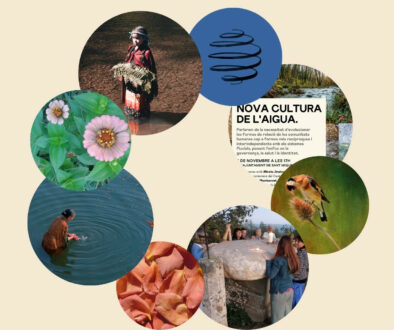In memory of Tich Nat Hanh: Interbeing and love for the Earth, the most beautiful of the bodhisattvas
Temple Từ Hiếu à Huế, Vietnam22 Jannuary 2022
Last January 22 Tich Nat Hanh passed away, and from Silene we want to pay a grateful and respectful tribute to him. Thay, as he was known, was for the West the great disseminator of Full Consciousness, an essential notion in Buddhism. From this spiritual tradition he was able to transmit his primordial wisdom. And he did it in a simple and profound way, reaching many people regardless of whether or not they were practicing a religion. A great defender of love and knowledge, he stood out for being a convinced and committed pacifist who proposed universal brotherhood not only among all men but also among all beings. Of all his teachings, we would like to highlight two of his most valuable contributions at this time.
On the one hand, Tich Nat Hanh was a great inspirer and renovator of the deep ecology with his concept of Interbeing. Based on the fact that the underlying problem of our predation on Earth is that man experiences himself as an individual consciousness and as a being separate from the rest of the web of life, he rethought the notion of dependent origin (pratityasamputpada) as an interdependent co-emergence, and proposed the powerful neologism ‘interbeing’, beautifully explained in the book The Heart of Understanding:
“If you are a poet, you will see clearly that there is a cloud floating in this sheet of paper. Without a cloud, there will be no rain; without rain, the trees cannot grow: and without trees, we cannot make paper. The cloud is essential for the paper to exist. If the cloud is not here, the sheet of paper cannot be here either. So we can say that the cloud and the paper inter-are.
“Interbeing” is a word that is not in the dictionary yet, but if we combine the prefix “inter” with the verb “to be”, we have a new verb, inter-be. Without a cloud, we cannot have paper, so we can say that the cloud and the sheet of paper inter-are.
If we look into this sheet of paper even more deeply, we can see the sunshine in it. If the sunshine is not there, the forest cannot grow. In fact nothing can grow. Even we cannot grow without sunshine. And so, we know that the sunshine is also in this sheet of paper. The paper and the sunshine inter-are. And if we continue to look we can see the logger who cut the tree and brought it to the mill to be transformed into paper. And we see the wheat. We know that the logger cannot exist without his daily bread, and therefore the wheat that became his bread is also in this sheet of paper. And the logger’s father and mother are in it too. When we look in this way we see that without all of these things, this sheet of paper cannot exist.
Looking even deeper, we see that we are in it too. This is not difficult to see, because when we look at a sheet of paper, it is part of our perception. Your mind is here and mine too. So we can say that everything is here on this sheet of paper – weather, space, earth, rain, minerals of the earth, sun, cloud, river, heat. Everything coexists with this sheet of paper. That’s why I think the word Interser should be in the dictionary. “Being” is interbeing.
You cannot be for yourself; you have to be interested in everything else. This sheet of paper is, because everything else is. Suppose we try to return one of the elements to its origin. Suppose we return the light to the sun. Do you think this sheet of paper would be possible? No, without sunlight nothing can be. And if we return the lumberjack to his mother, we have no role.
The fact is that this sheet is made only of non-paper elements. And if we return these elements to their origins, there can be no role at all. Without the elements that are not paper, such as the mind, the woodcutter, the sunlight, there will be no paper. As thin as it is, this sheet of paper contains the entire universe”.
On the other hand, Thay’s book A Song of Love on Earth is an invitation to build an intimate relationship with the source of all life. Transcending the scientific and economist approaches, it delves into one essential aspect: we must move towards a worldview that goes beyond the concept of “environment”, as this leads us to feel separated from the Earth and to see it only. in utilitarian terms. Our personal fullness is that of Nature, and vice versa. In the epilogue to the book, Towards a Cosmic Religion, we read:
Every step forward in our understanding of ourselves, our nature, and the place we occupy in the cosmos deepens our respect and love. Understanding and loving are two fundamental desires. Understanding has an important relationship with love. When we understand and are aware of the great harmony, elegance, and beauty of the cosmos, we can feel great admiration and love. This is the most basic type of religious sentiment, which is based on evidence and our own experience. Humanity it is a kind of spirituality that we can all practice together. […] In the 21st century it should be possible for us to unite and outline a form of religion that ends all separation and discrimination and contributes to uniting all peoples and nations. If religions, philosophies, and science can move in this direction, it will be possible to establish a cosmic religion that is not based on myth, belief, or dogma, but on the evidence and understanding of the Interser. That would be a really huge step for humanity. And as stated in the opening chapter of the same book, entitled We Are the Earth, “the Earth is the most beautiful of the bodhisattvas.”
Let us be worthy of this love, and let us return it to Earth, making Tich Nat Hanh’s words resonate until they come true. From Silene we thank them deeply, and make these words our own.
More information here




